PDF of this article (219 KB)
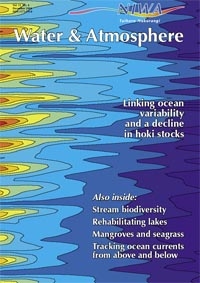
Anne-Maree Schwarz Fleur Matheson Trevor Mathieson
Seagrasses are integral to our estuaries and coastlines, but they are vulnerable to the impacts of development.
Seagrasses in the estuarine landscape
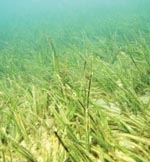
Seagrasses are the only flowering plants that grow in the sea. They probably colonised the marine environment about 100 million years ago from freshwater and coastal saltmarsh ancestors, and now they play an important role in coastal ecosystems. Not only do seagrass beds accumulate and stabilise sediments and contribute to food sources for other estuarine animals, but they also act as nursery areas for juvenile fish and serve as an important grazing area for water fowl.
In New Zealand we have one genus of seagrass, Zostera, which grows in soft sediments in estuaries and on some intertidal coastal rocky platforms. It is fully adapted to the marine environment, able to tolerate brackish as well as full-strength seawater, and able to withstand being exposed to the air during low tide.
Zostera beds can occupy considerable areas of intertidal sand flats; they can also extend into subtidal fringes in estuaries or form subtidal beds on offshore islands (such as Slipper Island and Great Mercury Island). This is noteworthy as NIWA research suggests that subtidal Zostera provides an important habitat for juvenile fish of commercially important species.
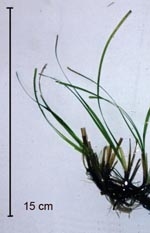
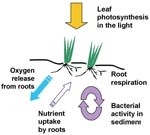

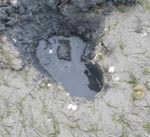
Though tolerant of a wide range of conditions, Zostera is vulnerable to decline, just as seagrasses have diminished worldwide (see box below). What is more, seagrass beds have been proven to be difficult to restore. Therefore it is particularly important to understand what contributes to the maintenance of a healthy seagrass bed.
Identifying healthy seagrass beds
As part of FRST-funded research, and in collaboration with various management agencies, NIWA scientists are studying the conditions that promote healthy seagrass beds in New Zealand. One aspect we have considered is the relationship between sediment conditions, growth, and seagrass health.
Seagrass health can be assessed by a range of measurements that include such things as leaf density and biomass and the photosynthetic characteristics of leaves. We have measured wide variability in these indicators across a range of estuaries and, while water clarity is an important factor for photosynthetic health, local sediment conditions also contribute to growth performance. We dug deeper to try to uncover the role sediment conditions might play in seagrass health.
Roots: the hidden half
Less visible than leaves but also important, seagrass roots and rhizomes (horizontal stems beneath the sediment surface) can form a considerable biomass beneath the sediment surface. These anchor the plants, preventing them from being swept away by the tides. The roots also extract nutrients for plant growth and can therefore profoundly affect the health of the photosynthesising leaves.
The relative proportion of leaves above the ground to the root and rhizome biomass below the ground differs from place to place. For example, where Zostera grows in sandy sediment in Whangapoua Harbour, there are persistent root layers present down to a depth of 7 cm below the surface. In contrast, a seagrass bed in much muddier sediments in Raglan Harbour has live roots to a depth of only 3 cm. Although leaf biomass is similar at both locations, total root biomass was much lower at the Raglan site.
How do the plants and sediments interact?
The most likely explanation for differences in root development is related to the characteristics of the sediment. Because estuarine sediments are periodically covered with water, they contain low levels of oxygen; in the picture below the dark-coloured anoxic sediment is evident just beneath the surface. These oxygen-poor sediments can be a hostile habitat: with ample organic matter, sediment bacteria produce reduced compounds like sulphide that are toxic to plants. Nevertheless, healthy seagrasses can counter this stress by transporting oxygen from their leaves to their roots; the oxygen is then used for respiration and nutrient uptake. Since roots are “leaky”, some of the oxygen is also lost to surrounding sediment and helps to maintain an oxidised zone around the plant roots and reduce the likelihood of harmful toxins accumulating.
As we dig down into the root zone of a seagrass bed, we see expected changes in organic matter, porewater sulphide, and the degree to which the sediment is oxidised. The measure of sediment oxidation is termed redox potential. Atmospheric oxygen can penetrate only a short distance into wet sediment, and so redox potential decreases rapidly with depth according to the depth of the root zone. As expected, our measurements found that concentrations of sulphide increase with depth as oxygen levels decrease.
Sediment processes and healthy seagrass beds
The sediment values we have measured in North Island estuaries fall within the range for seagrasses elsewhere in the world; in general, seagrasses tend to grow in sediments with an organic matter content of below 6%, redox potentials of 100 mV or more, and moderate porewater sulphide concentrations of less than 300 µM.
The leaf health indices that we have measured for plants growing within the desirable ranges of sediment conditions vary. We believe above-ground conditions such as water clarity are at least as important as sediments in determining the health of the seagrass beds. This kind of research can lead to a better understanding of how easily sediment conditions can shift outside of “desirable” ranges and how that affects plant growth. This will enable us to better predict the likely consequences of environmental change, such as changes in water clarity and quality.
Worldwide seagrass decline
Seagrasses occur around the world, and in total there are about 12 genera and 50 species. There have been many reports of diminishing seagrass beds and it has been estimated that more than 70% of the reported large-scale declines in the world have been due to human-induced disturbances. Once seagrass beds have been lost through environmental degradation, they are notoriously difficult to restore.
In New Zealand, the area of Zostera has been reported as declining over the last 50 years. In some places there is enough historical information to show that subtidal beds in estuaries – such as those in Tauranga Harbour – have undergone the greatest decline.
Further reading
Inglis, G.J. (2003). The seagrasses of New Zealand. In: Green, E.P.; Short, F.T. (eds). World atlas of seagrasses, pp. 134–143. Prepared by UNEP World Conservation Monitoring Centre. University of California Press, Berkeley.
Morrison, M.; Francis, M. (2001). In search of small snapper. Seafood New Zealand 9(10): 21–22.
Park, S.G. (1999). Changes in the abundance of seagrass (Zostera spp.) in Tauranga Harbour from 1959–96. Environmental Report 99/30, Environment Bay of Plenty, Tauranga.
Schwarz, A-M (2001). Diving-PAM helps gather information on foreign invaders. Aniwaniwa 18: 7.
Turner, S. (1995). Restoring seagrass systems in New Zealand. Water & Atmosphere 3(2): 9–11.
Anne-Maree Schwarz, Fleur Matheson, and Trevor Mathieson are all based at NIWA in Hamilton.
Funding for this study came from the FRST research programme “Aquatic Plant Management” (C01X0221), Environment Waikato, and Department of Conservation.
Teachers’ resource for NCEA AS: Biology 2.5, 2.7, 2.8; Geography 3.2. See other curriculum connections
